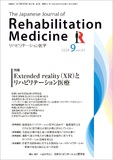Japanese
English
- 販売していません
- Abstract 文献概要
- 1ページ目 Look Inside
- 参考文献 Reference
要旨 目的:身体機能低下と社会的フレイルは心血管疾患の予後因子であるが,両者が併存した際の影響については検討の余地がある.また,療養支援者は心臓リハビリテーションにおける重要な社会的因子であるが,社会的フレイルでは考慮されていない.そこで身体機能の代表的指標である歩行速度低下と社会的フレイル,療養支援者不在の併存と退院後の有害事象リスクとの関連を調査した
方法:研究デザインは後ろ向きコホート研究であり,入院期心臓リハビリテーションに参加した65歳以上の者を対象とした.対象者を歩行速度低下(普通歩行速度<1.0 m/秒)と社会的フレイルの有無で4群に分け,退院後の複合イベント(死亡または再入院)の発生リスクとの関連を多変量Cox比例ハザードモデルで評価した.同様の解析を歩行速度低下と療養支援者の有無で群分けして実施した.
結果:解析対象は182名であった(中央年齢75歳).歩行速度低下はイベント発生のリスク因子であり,社会的フレイルの併存によりイベント発生リスクは上昇した.一方で,歩行速度と療養支援者不在で層別したときも両者を併存する者はイベント発生リスクが最も高かった.
結語:歩行速度低下で社会的フレイルを併存しているまたは療養支援者が不在の場合はイベントリスクが高く,退院後のリハビリテーション治療計画において社会資源の活用を含めた療養環境の調整を練る必要がある.
Abstract Objective:Physical function decline and social frailty are prognostic factors for cardiovascular disease;however, their combined effects remain to be examined. We aimed to investigate the association between post-discharge clinical events and the coexistence of decreased walking speed and social frailty or lack of caregivers in patients with cardiovascular disease.
Design:Retrospective cohort study.
Patients:Patients aged ≥65 years who participated in inpatient cardiac rehabilitation.
Methods:Patients were divided into four groups according to the presence of decreased walking speed (<1.0 m/sec) and social frailty or lack of caregiver. The association with a composite event risk (mortality or rehospitalization) was evaluated using a multivariate Cox proportional hazards model.
Results:This study included 182 patients (median age:75 years). When stratified according to reduced walking speed and social frailty, those with decreased walking speed showed a higher event risk, which further increased with social frailty. When stratified by declining walking speed and lack of caregivers, those with both factors exhibited the highest risk of the event.
Conclusion:Decreased walking speed with social frailty or lack of caregivers was associated with a higher poor post-discharge outcome risk. Our findings highlight the importance of adjusting the environment for disease management, including using social resources, when planning rehabilitation interventions after discharge.

Copyright © 2024, The Japanese Association of Rehabilitation Medicine. All rights reserved.


